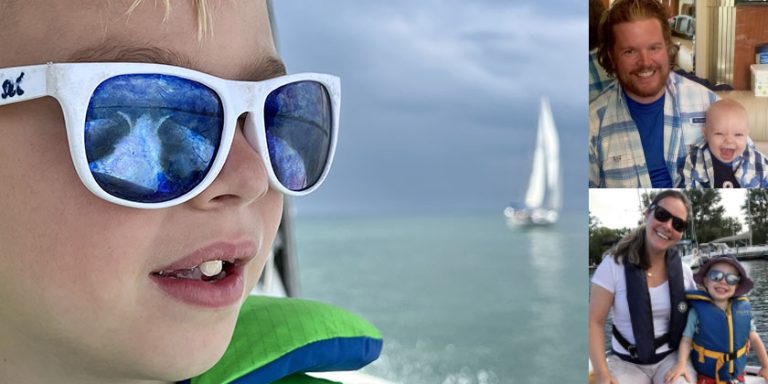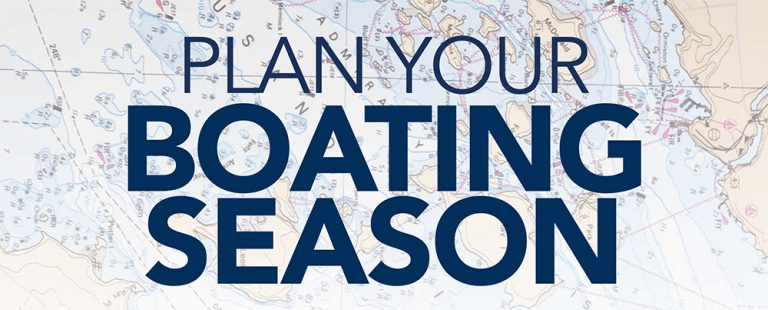Organizing Your Boat for Quick Getaways and More Efficient Storage
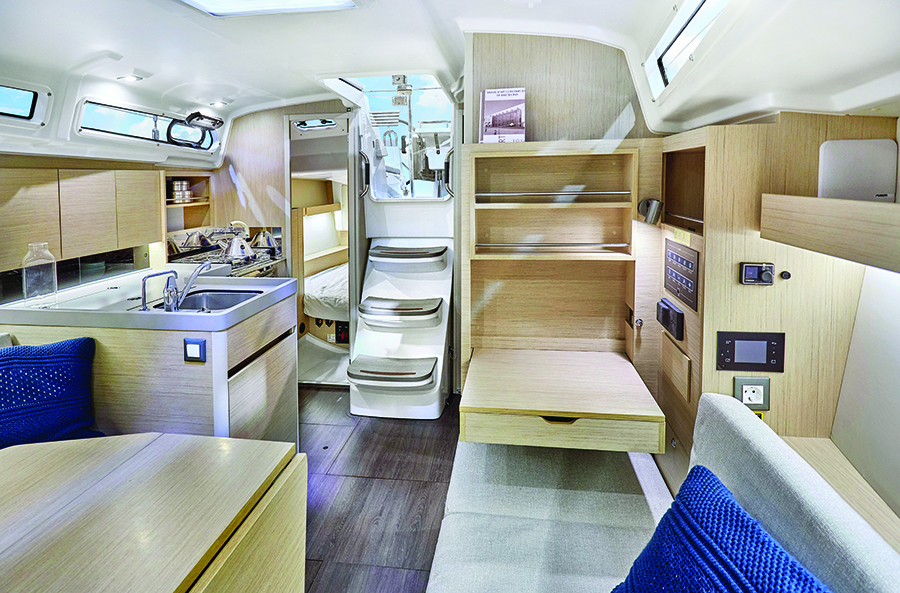
On Monday, hearing a good weather forecast, we agreed on a weekend sailboat getaway. Thus, on Friday afternoon, we embarked on our usual scramble to get aboard with food, drink, clothing and entertainment. As we stuffed the bags, I wondered where I’d put the swimsuits. Should I bring ketchup? Where’s the tablet and charger? Is there beer aboard? What am I forgetting?
Text and Photos by Marianne Scott
On Monday, hearing a good weather forecast, we agreed on a weekend sailboat getaway. Thus, on Friday afternoon, we embarked on our usual scramble to get aboard with food, drink, clothing and entertainment. As we stuffed the bags, I wondered where I’d put the swimsuits. Should I bring ketchup? Where’s the tablet and charger? Is there beer aboard? What am I forgetting?
We hauled our stuff to the garage, loaded the car, unloaded into a dock cart, lifted it onto the boat and stowed it. That evening, safely anchored, I lay in my bunk, exhausted, somewhat grumpy and mumbled, “I don’t do well in chaos. There’s got to be a more efficient way. How can we prepare ourselves and our boat for short and long cruises and reduce the draining work of just getting on and off the boat?”
 I live in Victoria. We don’t haul our boats during the winter. But like the rest of Canada we cruise mostly in the summer—although our season lasts longer. My hints on organizing yourself and your boat work across the country.
I live in Victoria. We don’t haul our boats during the winter. But like the rest of Canada we cruise mostly in the summer—although our season lasts longer. My hints on organizing yourself and your boat work across the country.
On an earlier boat, a plexiglass box stored daily needs in the head
Like most cruisers, my tasks are gender-based—David looks after water, fuel and the boat’s mechanics while I organize provisioning and everything else. We both navigate. Some families divide these tasks differently, but regardless, they must be completed whether you have a sail- or powerboat.
I’ve also sought to lessen what psychologists call the “mental workload,” the cognitive effort needed to organize tasks. In daily life, these include calling the plumber, checking emails, scheduling meetings, contacting a doctor’s office or making dinner. Going for a cruise demands additional mental (and physical) work. To shrink that workload, making checklists, updatable ones, became my first efficiency tool.
I made two lists—one for the items needed during the entire cruising season, and a second for things we must bring each getaway, while bearing in mind that not owning a megayacht, we need places to stow everything.
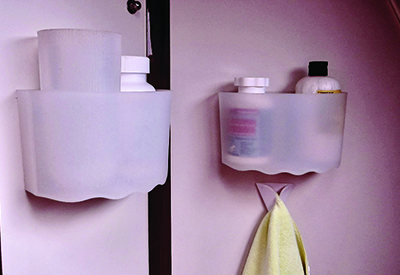
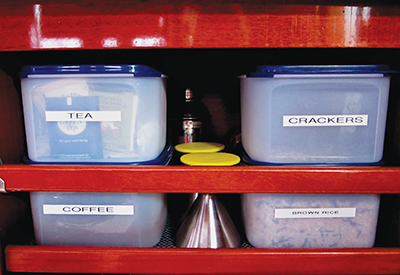
left: Suction baskets above toilet keep items from falling. Triangle holds hand towel.
Right: Keeping food supplies fresh
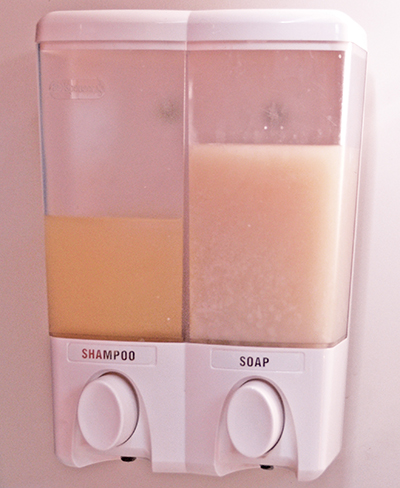 My Seasonal List includes life jackets (extras for guests), tethers, foulies, flares, flashlights and batteries, snorkel gear, VHF and navigation equipment, charts, and cruising guides. In the Pacific/Atlantic cold waters, you might invest in wetsuits.
My Seasonal List includes life jackets (extras for guests), tethers, foulies, flares, flashlights and batteries, snorkel gear, VHF and navigation equipment, charts, and cruising guides. In the Pacific/Atlantic cold waters, you might invest in wetsuits.
Soap and shampoo dispenser in the head
I itemized toiletries so I’d only have to bring them once. Toothbrushes/paste, sunscreen, shaving equipment, ibuprofen and acetaminophen, vitamins, our updated first-aid kit, insect repellent and deodorant came aboard for the summer. I recommend loading personal meds into dollar-store pill organizers. For soap and shampoo, I bought a dual chamber soap and shampoo dispenser, and attached it above the head-sink’s bulkhead, thereby avoiding rolling bottles and saving cabinet space. These are useful in a stand-alone shower as well. I also stocked a small pouch with make-up for the occasional spruce-up.
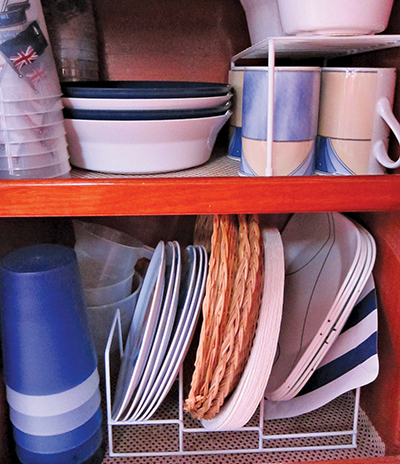 Rubber-covered racks expand storage space
Rubber-covered racks expand storage space
Our nights are cool so we need sheets, blankets and/or duvets. We can usually reuse bedding for several weekends so in between cruises, I store them in plastic bags and leave them on our bunks. When bedding needs washing, I bring it home (or marina laundry) in easy-to-fold duffels. Once washed, I put the bedding back in the same duffel ready for our next cruise. Ditto for towels, dish cloths and galley towels.
The right clothing depends on your climate and storage space. My lists include T-shirts, sweaters, shorts and jeans/slacks, swimsuits, underwear, pjs, socks, hats and jackets. I load them in their own duffel to bring aboard; after use I pack them to wash at home, then repack afterwards. The duplicates create redundancy but reduce stress.
Footwear is awkward to store. But topsiders, gumboots, hiking shoes, water shoes and maybe some flipflops should stay aboard. High heels are a definite no-no.
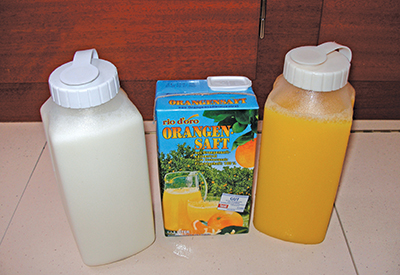
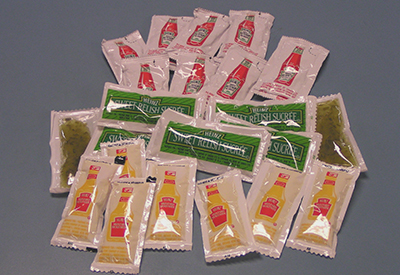
Left: Square containers fit better in the fridge
Right: Condiment packets
Proper food storage onboard can be controversial. What items can we store safely for months? Do canned goods really expire or is it a way for manufacturers to sell more? What foods need refrigeration? Many food manufacturers state on their containers, “Refrigerate after opening” and add “best before” dates. They may be worried about liability.
Having lived in Europe and sailed offshore when refrigeration is challenging, I learned to cool only the foods most likely to spoil: meat, fish and salad/veggies. But onions, apples, fruits, tomatoes, zucchini and eggs can easily last a weekend, even weeks, without refrigeration (after “candling” eggs to eliminate those with tiny cracks, they lasted six weeks offshore—even in tropical temperatures).
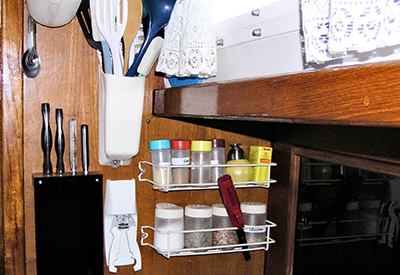
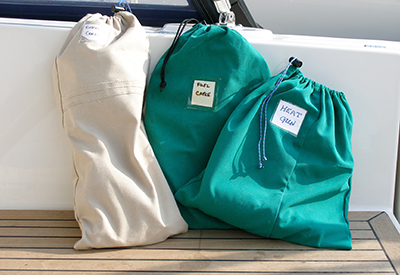
Left: A teak board and hooks host kitchen implements
Right: Bags for cords and corded appliances
Since ancient times it’s been known that vinegar preserves foods. So I don’t refrigerate ketchup, hot sauces, relish, pickles or mustard and stow them aboard—without refrigeration. Still, if you fear spoilage, you can stock a batch of individual ketchup, mustard and relish packets available at superstores. Peanut butter and jelly can remain unrefrigerated if you don’t contaminate the jelly with a dirty knife.
I stock up on favourite canned goods—soups, beans, sardines and diced tomatoes. If the can is intact, no dangerous pathogens can enter (canned soup I bought in Finland remained perfectly edible five years after its best-before-date.) A bulgy can top, however, requires instant disposal. During the week before cruises, I double up on stews, pasta dishes or casseroles rescuing me from onboard galley time and dishwashing.

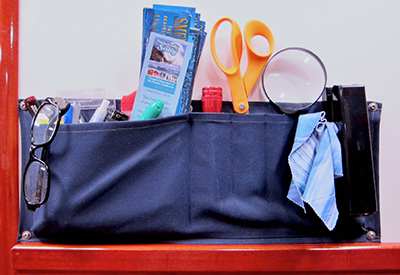
Left: Even the deckhead offers storage
Right: Handy sailcloth storage for office supplies
A vacuum packer is a useful friend. Small pouches of vacuum-packed parmesan, for example, will stay fresh for months—the anoxic environment preserves the cheese. You can adapt that method for many foods—even whole meals—that might otherwise spoil. I often place vacuum-packed items in the bilge lockers—BC’s waters range from 7℃-11℃ providing natural cooling.
I store flour, rice, pasta, coffee, tea, granola, oatmeal, honey, sugar, pancake mix, nuts and spices onboard for the season. One trick I used for our South Pacific voyage was to buy square, stackable, airtight Tupperware containers (square to maximize space in square cabinets/lockers). They were costly but have lasted for decades. Their contents stay fresh. (I’ve also bought Tupperware at thrift stores.) My home-office labelmaker provides waterproof labels.
For weekends, I’ve made a list of favourite foods. Meats to go on the barbie, bread, cheese, snacks, milk, yogurt, fruit—you’ll have your own choices. The list reduces my mental workload and as it’s on my phone, I add items during our cruise for our next excursion.
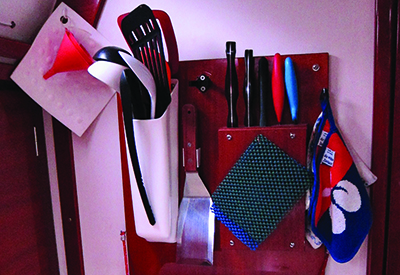 I always think “square” and use individual quart/litre bottles for milk, juice, oil, vinegar, dish soap and detergent. Many of these staple items are sold in plastic or glass shapes unsuited to a boat’s tight storage spaces, while square bottles fit under sinks, beneath-settees, even in bilges and around tanks. Recently, I’ve ordered food Grade-BPA-Free bottles through Amazon.
I always think “square” and use individual quart/litre bottles for milk, juice, oil, vinegar, dish soap and detergent. Many of these staple items are sold in plastic or glass shapes unsuited to a boat’s tight storage spaces, while square bottles fit under sinks, beneath-settees, even in bilges and around tanks. Recently, I’ve ordered food Grade-BPA-Free bottles through Amazon.
Another teak board and hooks host kitchen implements.
For drinks, I bring one-litre, square tetra packs whenever possible. Aluminum cans tend to develop pinholes in our salty environment, so I restock just a few fairly often. I stuff our wine supply into under-the-sole lockers, inserting the bottles into old or lost-mate socks to keep them from breaking or rolling noisily.
Entertainment items remaining on board include cards, Scrabble, puzzle books and boardgames—and books we’ve been meaning to read. I’ve duplicated chargers, cords and plugs for phones and music.
Bulkheads do more than hold up the deck. In the galley, I’ve placed a teak board on which I’ve fastened a knife block, winch-handle holder for spatulas, a rope paper-towel holder and spice racks. Only four screws backed by washers hold the teak board. Even the galley deckhead has hosted a stemware rack.
Galley doors have become lid holders; a cut-down plastic bottle holds our air horn next to the companion way for a quick grab. Easily obtainable rubber-coated racks extend storage in cabinets and attach to galley doors. Plastic baskets inside cabinets can store condiments.
 I’ve become a canvas adaptation and bag lady. I cut up an old sailcover and made the fabric into bags for corded appliances like the sander and heat gun; I sewed on plastic sleevelets to hold a label. A tall, skinny bag kept the four dinghy-oar parts from disappearing into the lazarette’s catacombs.
I’ve become a canvas adaptation and bag lady. I cut up an old sailcover and made the fabric into bags for corded appliances like the sander and heat gun; I sewed on plastic sleevelets to hold a label. A tall, skinny bag kept the four dinghy-oar parts from disappearing into the lazarette’s catacombs.
Our wine bottles in a sock.
Sunbrella also serves to increase storage space. Over the foot-end of forepeak and quarter-berth bunks, we installed a shelf and snapped on canvas, zippered covers. Canvas covers over the main saloon’s open cabinets keep things from spilling while heeling. Other custom bags attached to various bulkheads hold lifejackets, hats, tethers, sunglasses and other items.
I sewed pouches that hold pens, pencils, bookmarks, scissors and a magnifying glass over the nav table—the last thing we want to do is trip over a rolling pencil. Another small pouch holds our books and glasses over our bunk.
I bought a zippered binder to hold important paperwork, manuals and marine item packaging, and slid them into an individual plastic sleeves. I’ stapled the receipt to each manual for possible warranty issues. That one pouch kept these papers dry and accessible.
I developed my ideas over years, by trial and error, and asked fellow cruisers how they organized and stored their stuff. At one rendezvous, I asked every other cruiser for their best storage ideas and learned much.
 We’re fortunate to have sailed to the South Pacific, in the Baltic Sea, to Alaska and the wild and wonderful waters of British Columbia. We’ve lived aboard on 35- and 41-foot sailboats for long periods. To survive across oceans, having an organized boat is essential. But even in calmer realms, a tidy boat with everything properly planned and stowed adds enormously to the joy of cruising.
We’re fortunate to have sailed to the South Pacific, in the Baltic Sea, to Alaska and the wild and wonderful waters of British Columbia. We’ve lived aboard on 35- and 41-foot sailboats for long periods. To survive across oceans, having an organized boat is essential. But even in calmer realms, a tidy boat with everything properly planned and stowed adds enormously to the joy of cruising.
A zippered 3-ring binder contains our manuals


